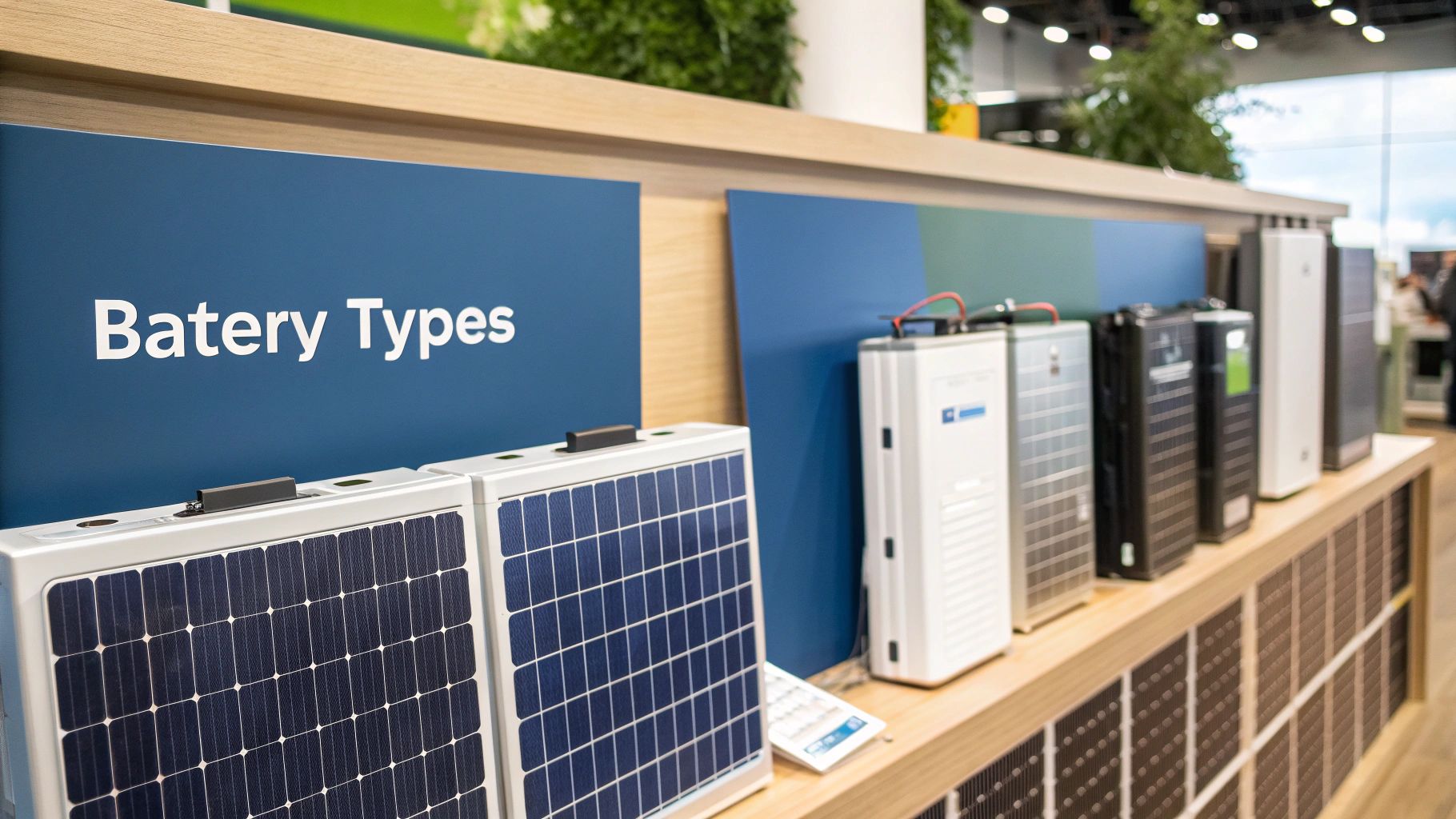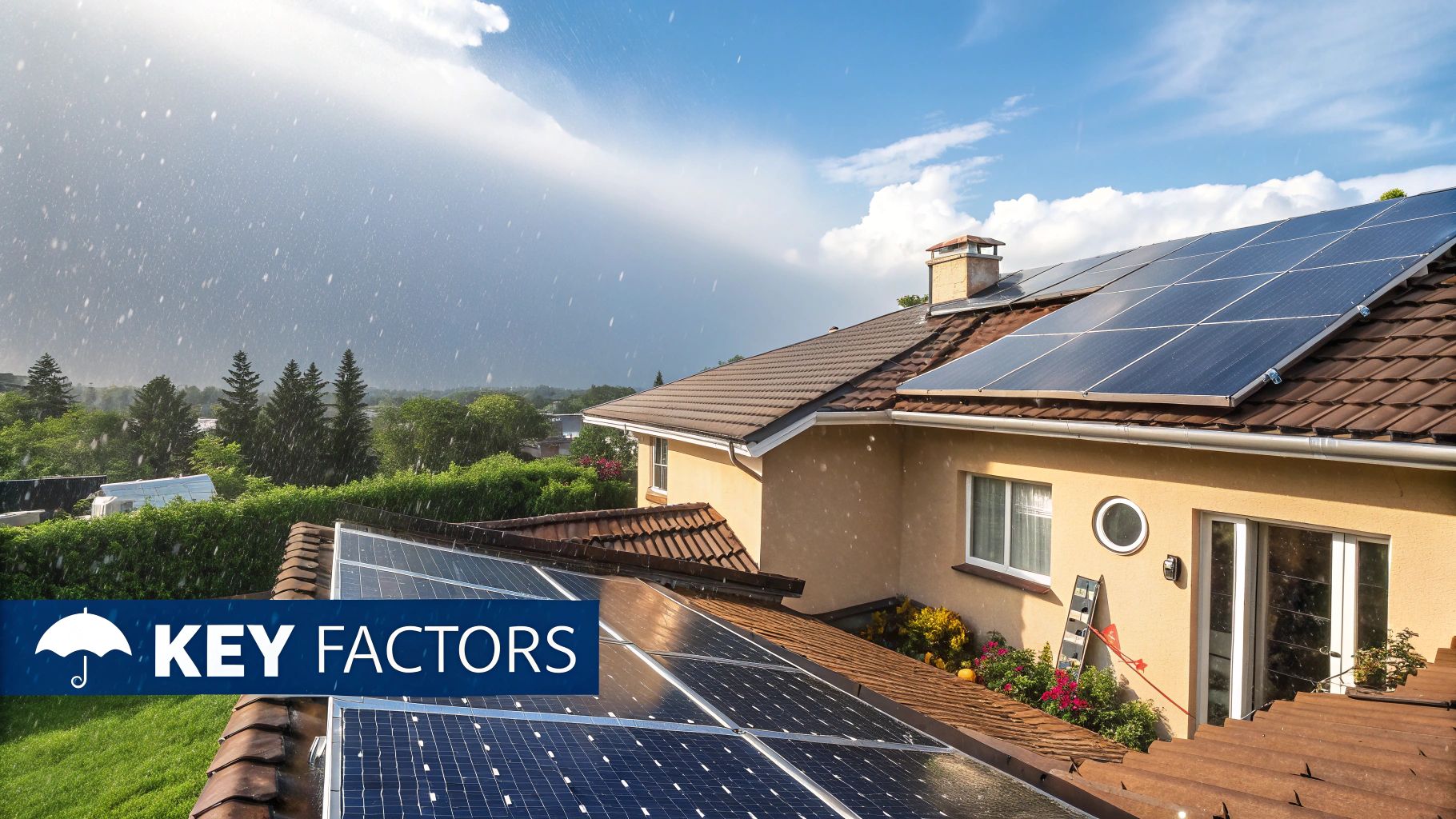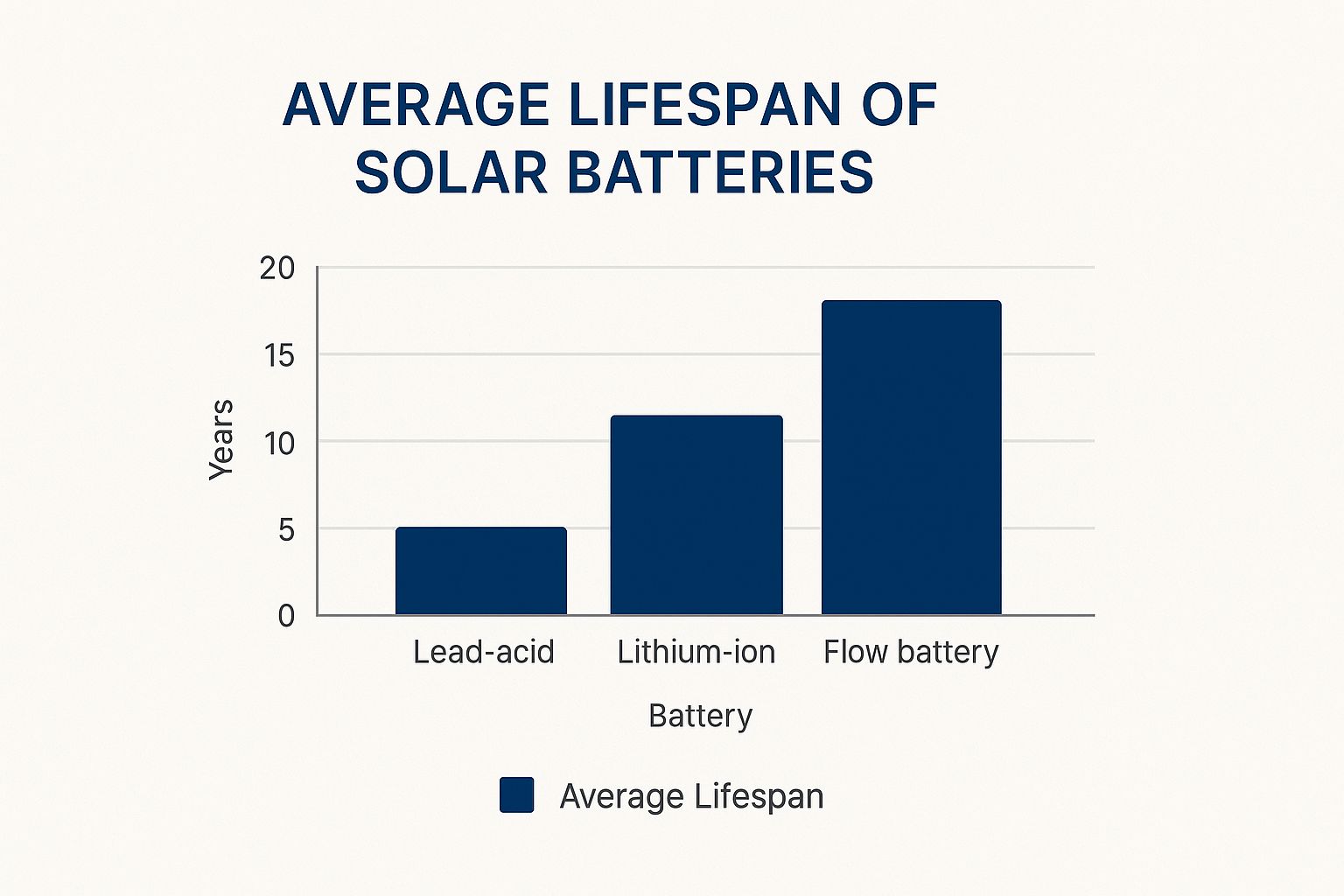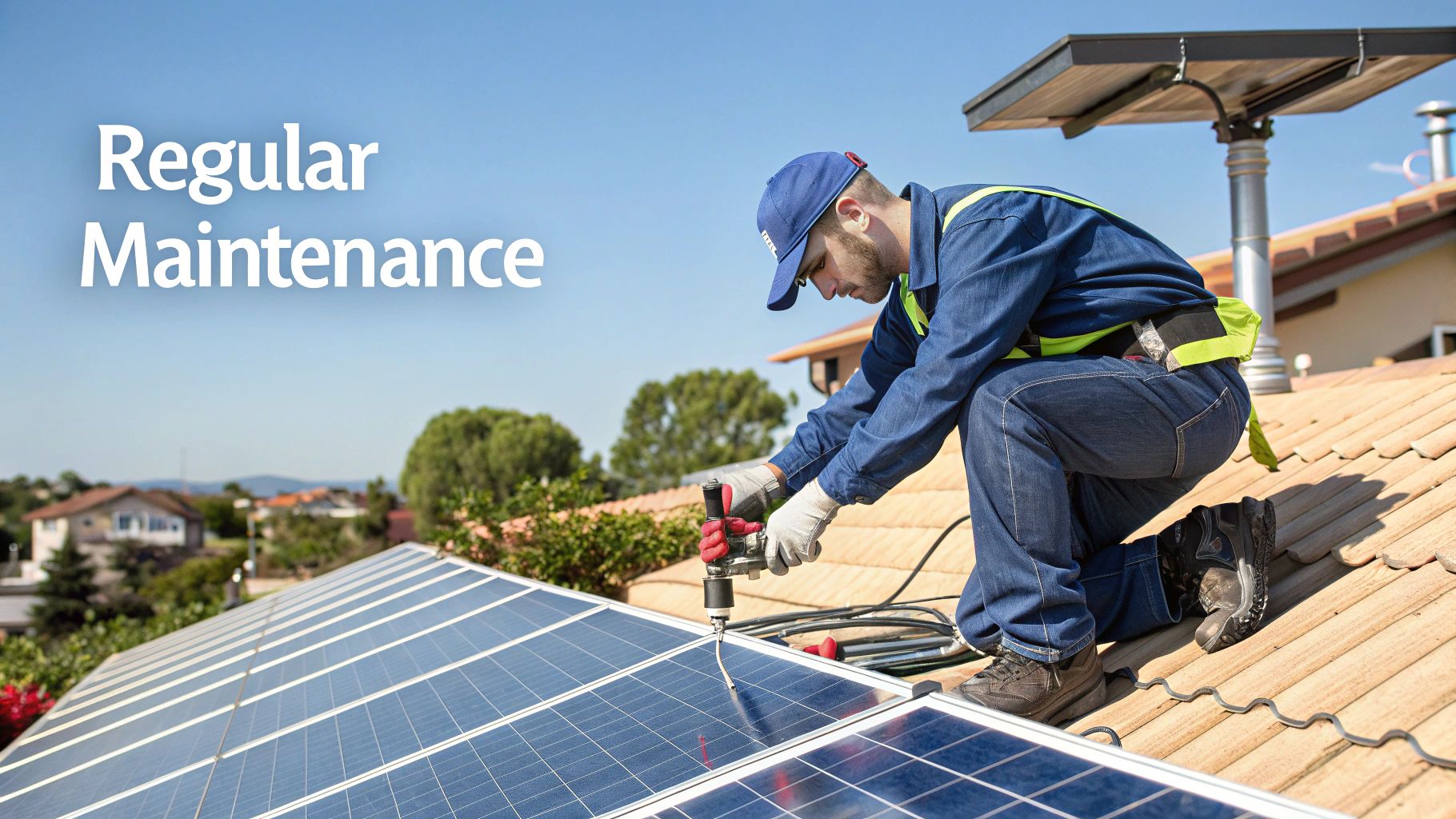How Long Do Solar Batteries Last? Maximize Their Lifespan
Investing in a solar battery is a big step towards taking control of your home's energy. But the big question is always: how long will it last before I need a new one?
For most homeowners, a quality solar battery should last somewhere between 5 and 15 years. Modern lithium-ion systems, which are the go-to choice these days, will almost always sit at the higher end of that range.
Understanding Your Solar Battery Lifespan
The best way to think about a solar battery is to compare it to your phone. When it's brand new, the battery seems to last forever. A few years down the track, you notice it needs charging more often because its maximum capacity has slowly faded. A solar battery ages in the same way—it’s a gradual decline, not a sudden stop.
This lifespan isn't a single, fixed number. It's the result of a few key factors working together. Here in Australia, how long your battery lasts really comes down to your local climate, how you use it day-to-day, and the specific chemistry inside it.
The lithium-ion batteries most Aussie households install are workhorses, generally good for 10 to 15 years. That translates to somewhere between 6,000 to 10,000 full charge-and-discharge cycles. Even after all that work, it's not dead; it just holds less charge, typically around 60% of what it could on day one, as detailed in these insights on Australian solar battery longevity from evergreenelectrical.com.au.
A battery's "end-of-life" doesn't mean it stops working. It simply means its ability to hold a full charge has reduced to a point where a replacement becomes a practical consideration for meeting your home's energy needs.
Solar Battery Lifespan at a Glance
To give you a clearer picture, here’s a quick comparison of the common battery types you'll find on the Australian market. This table breaks down what you can realistically expect in terms of lifespan, warranty, and long-term performance.
| Battery Type | Average Lifespan (Years) | Typical Warranty | End-of-Life Capacity |
|---|---|---|---|
| Lithium-Ion | 10–15 Years | 10 Years | 60–70% |
| Lead-Acid | 3–7 Years | 3–5 Years | 50% |
| Flow Battery | 20+ Years | 10–15 Years | 70–80% |
As you can see, the technology inside your battery makes a huge difference. While older lead-acid models are cheaper upfront, their shorter lifespan often makes them a more expensive choice in the long run.
Now that we've covered the basics, let's dig into the specific factors—from daily usage to where your battery is installed—that determine whether your investment lasts closer to five years or pushes well past fifteen.
What Determines Your Battery's Longevity

Think of your solar battery like a car. Its lifespan isn't just about calendar years; it’s about how it’s driven and looked after. Several key factors determine whether your battery gives up after five years or pushes well past fifteen. Understanding these elements shows you how your own habits directly impact the return on your investment.
These aren't just abstract technical terms. They are the real-world conditions that dictate how long your solar battery will actually last. Let's break down the most important ones.
Depth of Discharge
Depth of Discharge (DoD) is simply how much of your battery’s stored energy you use before it recharges. Imagine it’s the fuel tank in your car. Constantly running it down to the last drop puts more stress on the system than keeping it at least a quarter full.
It’s the same with a battery. One that is frequently drained completely experiences more wear and tear than one that is only partially discharged. A higher DoD means the battery can complete fewer total cycles over its lifetime.
- Shallow Discharge: Using only 30% of your battery’s capacity before recharging is gentle and helps it live a longer life.
- Deep Discharge: Regularly using 90% of the capacity puts more strain on the internal components, which can shorten its overall lifespan.
Thankfully, modern lithium-ion batteries are built for this kind of work, with most offering a high DoD of 90% or more. Still, being mindful of this principle can make a real difference to its long-term health.
Total Energy Throughput
If DoD is how hard you press the accelerator, then throughput is the total kilometres on your car’s odometer. It’s a measure of all the energy that has passed through your battery—both in and out—over its entire life.
Most manufacturers specify a total energy throughput in their warranty, often measured in megawatt-hours (MWh). For instance, a warranty might cover the battery for 10 years or 30 MWh of throughput, whichever comes first. If you use your battery heavily every day, you'll reach that MWh limit sooner.
Throughput gives you a far more accurate picture of a battery's working life than cycles alone. It accounts for every single kilowatt-hour the battery processes, reflecting its true level of use.
The Impact of Australian Climate
Climate, especially temperature, plays a huge role in a battery’s lifespan. Extreme heat is the enemy of battery health, as it speeds up the chemical degradation inside. Think of it like leaving your smartphone on the dashboard of a hot car—it gets sluggish, and the battery drains in no time.
Solar batteries perform best in stable, cool environments, ideally between 15-25°C.
Installing a battery in a hot, unventilated shed or on a wall that gets belted by the afternoon sun will absolutely shorten its life. A cooler, sheltered spot like a garage is always the best choice to protect your investment from Australia's harsh summer temperatures. This one decision can add years to its operational life.
Decoding Battery Cycles and Lifespan Claims

When you look at a battery’s warranty, the term “cycle life” is one of the most important figures you’ll see. So, what exactly is a cycle, and how does it tell you how long your battery will actually last?
A cycle is simply one full charge and one full discharge. Think of it as a full breath for your battery: breathing in solar energy until it’s full, then breathing it out to power your home. It’s a far more accurate measure of a battery's working life than calendar years alone.
Translating Cycles into Years
Let’s do some quick maths to see what this means in the real world. If a battery is rated for 10,000 cycles and you run it through one full cycle each day (charging up from the sun, discharging overnight), that battery could theoretically last for over 27 years.
Of course, that’s an estimate. Real-world conditions always play a part. But it highlights just how crucial that cycle rating is. A battery rated for 3,000 cycles, which is common for some older chemistries, would last closer to 8 years with daily use. You can read more about typical solar battery lifespans in Australia on cyanergy.com.au.
A high cycle life is one of the clearest indicators of a durable, long-lasting battery. It shows the manufacturer's confidence in the internal chemistry and its ability to withstand thousands of charges and discharges without significant degradation.
This is exactly why Lithium Iron Phosphate (LFP) batteries have become the go-to choice in Australia. Their chemistry is incredibly stable, allowing them to hit impressive cycle counts—often more than 10,000 cycles—when operated correctly.
Not All Cycles Are Created Equal
It's also important to know that not every cycle puts the same amount of stress on your battery. How deeply you discharge it plays a huge role in its long-term health.
- Shallow Cycles: Discharging your battery by only 30-40% before it recharges is very gentle. It's like going for a light jog instead of a full sprint.
- Deep Cycles: Routinely draining the battery right down to its limit (say, a 90% Depth of Discharge) is much harder on the internal components.
While modern batteries are built to handle deep cycles, a regular pattern of shallower discharges will generally extend its operational life even further. Understanding this helps you see past the marketing claims and truly assess how a solar battery will perform year after year.
Comparing the Best Solar Battery Technologies
Picking the right solar battery for your home isn’t just about the biggest capacity you can find. It’s about matching the technology to your needs, your budget, and how you live. The Australian market has a few key chemistries, and each one has a different story to tell when it comes to performance and how long it will last.
H3: Lead-Acid: The Old Workhorse
For years, Lead-Acid batteries were the go-to. Think of them as the reliable old ute of the energy world—they were affordable and got the job done, but they weren't exactly efficient or built for the long haul.
You'd be lucky to get 3–7 years out of them, and you could only use about half their stored power without causing damage. This low Depth of Discharge made them a tough fit for a modern home trying to cycle energy every day.
H3: Lithium-Ion: The Modern Standard
These days, Lithium-Ion batteries are the clear favourite for home energy storage, and for very good reason. They hit the sweet spot, offering a great balance of lifespan, efficiency, and cost.
Specifically, Lithium Iron Phosphate (LFP) is a popular choice here in Australia, valued for its stability and excellent safety record. These batteries will comfortably last 10 to 15 years and can be discharged by 90% or more, meaning you get to use almost all the energy you’ve stored.
H3: Sodium-Ion: The New Contender
Looking ahead, new chemistries are starting to make a name for themselves. Sodium-Ion batteries are gaining serious attention as a promising alternative, especially for those prioritising safety and sustainable materials.
While still a newer technology, their development is one to watch. If you're curious about the next wave, you can explore the latest info on Sodium-Safe batteries available in Australia.
To put it all in perspective, the chart below gives a quick visual comparison of how these technologies stack up on lifespan.

As you can see, the jump from older lead-acid technology to modern lithium-ion is significant.
While the upfront price tag is always a consideration, the true cost of a battery emerges over its lifetime. A cheap battery that needs replacing every five years can easily end up costing more than a premium model that soldiers on for fifteen.
To help you weigh the trade-offs, here’s a simple table breaking down the key differences between the most common solar battery types in Australia.
H3: Comparison of Solar Battery Types
| Feature | Lithium-Ion (LFP/NMC) | Lead-Acid | Sodium-Ion |
|---|---|---|---|
| Average Lifespan | 10–15 Years | 3–7 Years | 10+ Years (Projected) |
| Cycle Life | 6,000–10,000+ Cycles | 500–1,000 Cycles | 4,000–6,000+ Cycles |
| Depth of Discharge | 90–100% | 50% | 90%+ |
| Typical Warranty | 10 Years | 3–5 Years | 10 Years (Varies) |
| Best For | Daily cycling, high efficiency | Off-grid, low-cost setup | Eco-conscious users, safety |
Ultimately, understanding how long a solar battery will last means looking past the warranty years and at the technology powering it. For most Aussie homes right now, lithium-ion delivers the best long-term value and performance.
Practical Tips to Extend Your Battery's Life

Knowing what shortens a solar battery’s life is half the battle. The other half is turning that knowledge into action to protect your investment. With a few straightforward strategies, you can help your battery perform better and last longer, making sure you get the most out of it for years to come.
These aren't complicated technical tweaks. They're just practical choices that make a real difference to your battery's long-term health.
Choose the Right Installation Spot
Where your battery lives is one of the most important decisions you'll make. Extreme heat is a battery's worst enemy, as it speeds up chemical degradation and cuts its lifespan short.
- Avoid Direct Sunlight: Never install a battery on a wall that gets baked by the harsh afternoon sun.
- Seek Shelter and Ventilation: A cool, dry, and well-ventilated spot like a garage is ideal. This helps the battery maintain a stable operating temperature, which is crucial for its longevity.
A smart installation location can easily add years to your battery’s working life.
Optimise Your Battery Settings
Modern solar batteries aren't just "set and forget" devices. They come with intelligent software you can use to encourage healthier operation.
The most important setting to manage is the Depth of Discharge (DoD). While lithium-ion batteries are built to handle deep discharging, consistently running them down to empty puts unnecessary stress on their components. Setting a minimum reserve—say, 10%—ensures the battery never fully drains. This simple step reduces wear and tear over thousands of cycles.
Your battery's brain is its Battery Management System (BMS). This unsung hero automatically protects it from overcharging, overheating, and excessive discharging, acting as a built-in safety net.
A quality BMS is non-negotiable for a long and healthy battery lifespan. As you get your system set up, understanding your options is key, which is why familiarising yourself with information on solar battery safety in Australian homes can provide valuable context and peace of mind.
Monitor Performance and Stay Informed
Finally, keep an eye on your system. Most modern batteries come with a user-friendly app that lets you track performance, including charge levels and daily energy use.
Checking this data regularly helps you spot any unusual behaviour early. If you notice its capacity seems to be dropping faster than expected, you can get it checked before minor issues become bigger problems.
Planning for Your Home's Energy Future
As more Aussie households go solar, batteries are fast becoming a standard part of the setup. It’s a practical shift, driven by a desire for a bit more energy independence and by some serious improvements in battery tech.
The trend is impossible to miss. Between 2022 and 2023, Australia saw a whopping 55% jump in home battery installations, with nearly 50,000 new systems plugged in. This isn't happening by accident. Better battery lifespans and government support are making it a smart move for homeowners. You can get more details on Australia's battery boom on solarpowernation.com.au.
A Planned Upgrade, Not a Failure
Here’s the key takeaway: a 5-to-15-year lifespan for a home battery is the current industry standard. With the right choices and a bit of care, you can confidently aim for the higher end of that range.
Instead of seeing a future replacement as a problem, it’s much healthier to view it as a planned upgrade in your home’s energy journey.
Think of it like replacing the tyres on your car. You do it to keep things safe and running at their best, not because the car itself has failed. Your battery replacement, likely a decade or more from now, is exactly the same—a sensible step forward.
When the time comes to replace your battery, you won't just be buying the same technology. You'll be upgrading to a system that is more efficient, longer-lasting, and potentially more affordable than what's available today.
Embracing Continuous Improvement
This long-term perspective is actually pretty empowering. Battery technology is constantly getting better, which means the system you buy in the future will almost certainly offer better performance.
By joining a network now, you get the most value out of your current system while setting yourself up for that future upgrade. Our guide explains how a Virtual Power Plant in Australia helps you earn more from the solar you’re already generating.
Ultimately, your decision to install a solar battery today puts you on the path to greater energy control. Each new generation of technology will only strengthen that independence, building a smarter and more resilient future for your home.
Your Questions Answered
When you're investing in a home battery, you want straightforward answers, not jargon. Let's tackle some of the most common questions homeowners have about how long their battery will really last.
Will My Solar Battery Suddenly Stop Working?
Thankfully, no. It’s not like a lightbulb that just burns out one day. A solar battery's "end of life" is a much slower, more gradual process.
Over years of use, its ability to hold a full charge will slowly decrease. Most warranties guarantee it will still hold a certain percentage of its original capacity—usually around 60-70%—after about a decade. Your battery will absolutely still work, but you'll notice it won't power your home for quite as long overnight as it did when it was new.
Is a Longer Warranty Always Better?
A long warranty is a great sign of a manufacturer's confidence, but you have to read the fine print. The number of years is only part of the story.
You need to pay close attention to two key figures:
- The guaranteed end-of-life capacity: A 10-year warranty that promises 70% capacity is often a better deal than a 12-year one guaranteeing only 60%.
- The number of cycles covered: This tells you how much work the battery is guaranteed to do within that time.
A strong warranty isn't just a piece of paper; it's a performance guarantee. It protects your investment by setting a clear benchmark for what you can expect, ensuring you get the value you paid for.
How Does the Australian Climate Affect Battery Life?
Extreme heat is the biggest enemy of battery health in Australia. Lithium-ion batteries are happiest and perform best in stable, cooler temperatures—ideally somewhere between 15-25°C.
When a battery is constantly exposed to high heat, the chemical reactions inside speed up, which leads to faster degradation and a shorter lifespan. This is exactly why the installation location is so critical. A cool garage will always be a better choice than a wall that gets blasted by the hot afternoon sun.
Ready to make the most of your solar and battery system? Join HighFlow Connect's Virtual Power Plant to earn extra income from your stored energy while supporting a more stable grid. Learn more and sign up today.


